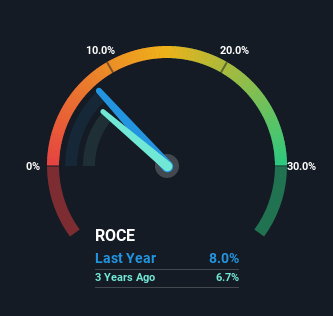What are the early trends we should look for to identify a stock that could multiply in value over the long term? One common approach is to try and find a company with returns on capital employed (ROCE) that are increasing, in conjunction with a growing amount of capital employed. This shows us that it's a compounding machine, able to continually reinvest its earnings back into the business and generate higher returns. Having said that, from a first glance at Taylor Devices (NASDAQ:TAYD) we aren't jumping out of our chairs at how returns are trending, but let's have a deeper look.
Understanding Return On Capital Employed (ROCE)
For those that aren't sure what ROCE is, it measures the amount of pre-tax profits a company can generate from the capital employed in its business. To calculate this metric for Taylor Devices, this is the formula:
Return on Capital Employed = Earnings Before Interest and Tax (EBIT) ÷ (Total Assets - Current Liabilities)
0.08 = US$3.5m ÷ (US$49m - US$5.1m) (Based on the trailing twelve months to August 2022).
So, Taylor Devices has an ROCE of 8.0%. In absolute terms, that's a low return and it also under-performs the Machinery industry average of 10%.
See our latest analysis for Taylor Devices

Historical performance is a great place to start when researching a stock so above you can see the gauge for Taylor Devices' ROCE against it's prior returns. If you'd like to look at how Taylor Devices has performed in the past in other metrics, you can view this free graph of past earnings, revenue and cash flow.
What Can We Tell From Taylor Devices' ROCE Trend?
The returns on capital haven't changed much for Taylor Devices in recent years. The company has consistently earned 8.0% for the last five years, and the capital employed within the business has risen 33% in that time. Given the company has increased the amount of capital employed, it appears the investments that have been made simply don't provide a high return on capital.
The Key Takeaway
In summary, Taylor Devices has simply been reinvesting capital and generating the same low rate of return as before. Since the stock has declined 13% over the last five years, investors may not be too optimistic on this trend improving either. In any case, the stock doesn't have these traits of a multi-bagger discussed above, so if that's what you're looking for, we think you'd have more luck elsewhere.
If you'd like to know about the risks facing Taylor Devices, we've discovered 1 warning sign that you should be aware of.
If you want to search for solid companies with great earnings, check out this free list of companies with good balance sheets and impressive returns on equity.
Valuation is complex, but we're here to simplify it.
Discover if Taylor Devices might be undervalued or overvalued with our detailed analysis, featuring fair value estimates, potential risks, dividends, insider trades, and its financial condition.
Access Free AnalysisHave feedback on this article? Concerned about the content? Get in touch with us directly. Alternatively, email editorial-team (at) simplywallst.com.
This article by Simply Wall St is general in nature. We provide commentary based on historical data and analyst forecasts only using an unbiased methodology and our articles are not intended to be financial advice. It does not constitute a recommendation to buy or sell any stock, and does not take account of your objectives, or your financial situation. We aim to bring you long-term focused analysis driven by fundamental data. Note that our analysis may not factor in the latest price-sensitive company announcements or qualitative material. Simply Wall St has no position in any stocks mentioned.
About NasdaqCM:TAYD
Taylor Devices
Designs, develops, manufactures, and markets shock absorption, rate control, and energy storage devices for use in machinery, equipment, and structures in the United States, Asia, and internationally.
Flawless balance sheet and good value.
Similar Companies
Market Insights
Community Narratives




